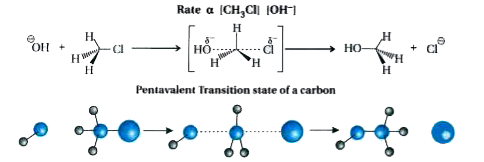Write a note on SN2 mechanism. Solution in Gujrati
The reaction in which the reaction rate depends both on the concentration of substrate and nucleophile is called SN2 reaction or substitution nucleophilic biomolecular reactions. For example, reaction between CH3−Cl and hydroxide ion to yield methanol and chloride ion follows a second order kinetics.

The incoming nucleophile interacts with the alkyl halide causing the carbon - halide bond to break and a new bond is formed between carbon and attacking nucleophile. Here it is C - O bond formed between C and - OH. These two processes take place simultaneously in a single step and no intermediate is formed.
In a reaction, the bond between incoming nucleophile and the carbon atom starts forming, the bond between carbon atom and leaving group weakens and as a result, the carbon - hydrogen bonds of the substrate start moving away from the nuclephile. In a transition state all the three C - H bonds are in the same plane and the attacking and leaving nucleophiles are partially attached to the carbon. Thus, in a transition state carbon is bonded to five atoms simultaneoulsy. Such structure is unstable and cannot be isolated.
During the reaction, as the attacking nucleophile approaches closer to the carbon, C - H bonds still keep on moving in the same direction till attacking nucleophile attaches the carbon and leaving group leaves the carbon. This is known as inverted in a same way as an umbrella is inerted in a same way as umbrella is inverted inside out when caught in a strong wind.
Topper's Solved these Questions
- BOOK - KUMAR PRAKASHANCHAPTER - HALOALKANES AND HALOARENESEXERCISE - SECTION - B INTEXT QUESTIONS AND ANSWERS20videos
HALOALKANES AND HALOARENES
- BOOK - KUMAR PRAKASHANCHAPTER - HALOALKANES AND HALOARENESEXERCISE - SECTION - C TEXTUAL EXERCISE87videos
HALOALKANES AND HALOARENES
- BOOK - KUMAR PRAKASHANCHAPTER - HALOALKANES AND HALOARENESEXERCISE - SECTION - E Multiple Choice Questions260videos
HALOALKANES AND HALOARENES
- BOOK - KUMAR PRAKASHANCHAPTER - GENERAL PRINCIPLES AND PROCESSES OF ISOLATION OF ELEMENTSEXERCISE - SECTION - E (MCQs ASKED IN GUJET/BOARD EXAMS)46videos
GENERAL PRINCIPLES AND PROCESSES OF ISOLATION OF ELEMENTS
- BOOK - KUMAR PRAKASHANCHAPTER - POLYMERSEXERCISE - SECTION - E (MCQs asked in Board Exams)51videos
POLYMERS
Similar Questions
Write the structures of the following compounds :
2-Chloro-3-methylentane00:52View SolutionName the following halides according to IUPAC system and classify them as alkyl, allyl, benzyl (primary, secondary, tertiary), vinyl or aryl halides :
(CH3)2CHCH(Cl)CH3View SolutionThe derivatives that are not found in nature are …..
04:04View SolutionDuring electrolysis of aqueous solution of Na2SO4 using graphite electrode .........
View SolutionWhich polymer is used in preparation of capsules ?
View SolutionS_(N)2 mechanism proceeds through formation of :
View SolutionS_(N^(2)) mechanism proceeds through the formation of
View SolutionExplain the mechanism of S_(N^(1)) and S_(N^(2)) reactions with examples.
03:29View SolutionCompare SN1andSN2 reaction mechanisms.
02:45View SolutionCompare S_(N^1)and S_(N^2 reaction mechanisms.
05:24View SolutionCompare SN1 and SN2 reaction mechanisms.
06:25View SolutionExplain the mechanism of S_(N^(2)) reaction.
02:58View SolutionExplain SN2 reaction mechanism of haloalkanes.
07:06View SolutionExplain SN2 reaction mechanism of haloalkanes.
03:48View SolutionWrite a note on SN1 reaction.
07:14View Solution

